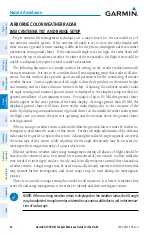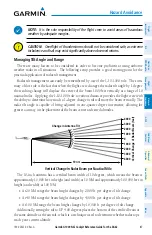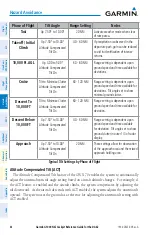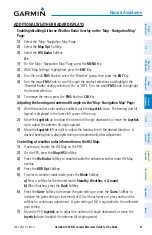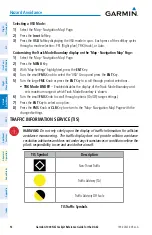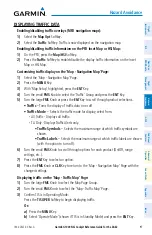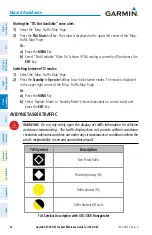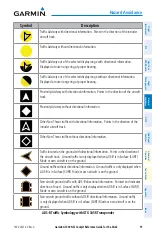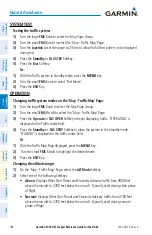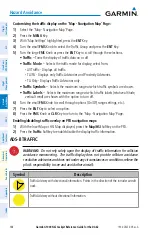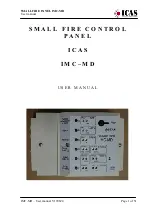
Garmin G1000 NXi Cockpit Reference Guide for the da62
190-02622-00 Rev. A
87
Hazard avoidance
Flight
Instruments
EIS
Nav/Com/
XPDR/Audio
Flight
Management
Hazar
d
Avoidance
AFCS
Additional
Featur
es
Annun/Alerts
Appendix
Index
Flight
Instruments
EIS
Nav/Com/
XP
d
R/
a
udio
Flight
Management
Hazar
d
avoidance
a
FCS
a
dditional
Featur
es
a
bnormal
o
per
ation
a
nnun/
a
lerts
a
ppendix
Index
NoTE:
It is the sole responsibility of the flight crew to avoid areas of hazardous
weather by adequate margins.
CaUTIoN:
Overflight of thunderstorms should not be considered safe, as extreme
turbulence and hail may exist significantly above observed returns.
Managing Tilt angle and Range
There are many factors to be considered in order to become proficient at using airborne
weather radar in all situations. The following setup provides a good starting point for the
practical application of radar tilt management.
Radar tilt management can easily be remembered by use of the 1-10-1000 rule. The sum-
mary of this rule is the fact that when the flight crew changes the radar tilt angle by 1 degree
the resulting change will displace the center of the beam 1000 feet vertically at a range of 10
nautical miles. Applying the 1-10-1000 rule to various distances provides the flight crew with
the ability to determine how much a 1-degree change in tilt will move the beam vertically. The
radar tilt angle is capable of being adjusted in one-quarter degree increments, allowing for
greater accuracy in the placement of the beam center at desired altitudes.
Vertical Change of Radar Beam (feet)
Change in Antenna Tilt
10 nm
0
1000
2000
3000
4000
1000
2000
3000
4000
-1°
0°
-2°
-3°
-4°
+1°
+2°
+3°
+4°
Vertical Change in Radar Beam per Nautical Mile
The 10-inch antenna has a certified beam width of 10 degrees, which means the beam is
approximately 10,000 feet in height (and width) at 10 NM and approximately 100,000 feet in
height (and width) at 100 NM.
»
At 20 NM range the beam height changes by 2,000 ft. per degree of tilt change.
»
At 40 NM range the beam height changes by 4,000 ft. per degree of tilt change.
»
At 100 NM range the beam height changes by 10,000 ft. per degree of tilt change.
Additionally, setting the tilt to UP 4.00 degrees places the bottom of the certified beam at
the same altitude as the aircraft, which is a technique used to determine whether radar tops
reach your current altitude.
Содержание G1000 NXi
Страница 1: ...Cockpit Reference Guide Diamond DA62 System Software Version 2056 10 or later...
Страница 2: ......
Страница 4: ......
Страница 14: ...Garmin G1000 NXi Cockpit Reference Guide for the DA62 190 02622 00 Rev A Warnings Cautions Notes Blank Page...
Страница 16: ...Garmin G1000 NXi Cockpit Reference Guide for the DA62 190 02622 00 Rev A Software License Agreement Blank Page...
Страница 18: ...Garmin G1000 NXi Cockpit Reference Guide for the DA62 190 02622 00 Rev A 14 Record of Revisions Blank Page...
Страница 219: ......














